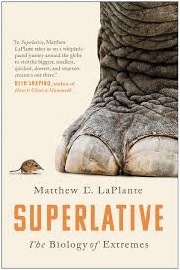Superlative: The Biology of Extremes

Matthew D LaPlante
BenBella Books, £17.99
Did you know that the African elephant, the largest land animal, could help find a cure for cancer or that the Goliath frog could shed light on the science of aging? The giraffe on the other hand has advanced the question of speciation by the discovery that it is not one species but several, all thanks to DNA analyses that showed extensive genetic diversity between populations. At the heart of these stories are organisms at the extremes of biology. The biggest, the tallest, the fastest, the oldest and the noisiest – and thus the most superlative results of evolution.
LaPlante writes his book as a personal account of his research into the extremes of living things, an interest first piqued by a meeting with a baby elephant in a zoo. The non-formal style is brilliant to read, but there is a scientific depth that shows a great understanding of the fragility and importance of all living things.
Superlative comprises eight chapters covering the greatest and the tallest, the smallest and the smartest – which, as far as the author is concerned, is not human. Each chapter has sections not listed on the contents pages and this would have been useful as some sections are particularly fascinating – for example, the one on the hog-nosed bat, aka the bumblebee bat and the world’s smallest mammal. However, each chapter is expanded in a notes section toward the end of the book and there is a comprehensive index.
Superlative is a refreshing and accessible work, full of fascinating content and at a price that surely does not reflect the effort of creating it.
Pat Sang MRSB


